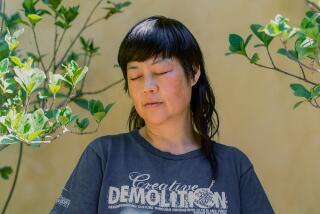S.D. GALLERY MADE IT THE HARD WAY
- Share via
SAN DIEGO — You’d think you were visiting a cutting-edge L.A. gallery. That’s what owner Patty Aande wants you to think.
The sophistication of its interior--white walls, gray floor--created by designer-carpenter Chris Jung, does not disguise the industrial origins of the open-beamed, concrete-block structure, which was a parachute factory during World War II.
It is just right for showing the challenging kind of art that Patty Aande prefers--seductive, playful, intelligent and a little rough.
“I wanted to create a space in San Diego where works of art are exhibited like something special, not like decorative commodities,” she stated in a recent interview. “And I have,” she added proudly.
At the Patty Aande Gallery, visitors find the mysterious and lush suburban images of Astrid Preston; the minimal, imagined landscapes of Gillian Theobald, and the antic, off-the-wall, papier mache sculptures of Amanda Farber. You might stub your toe on a realistic, cast concrete man’s head by conceptual artist Allen Ruppersberg.
Aande now represents a preponderance of Los Angeles artists such as Roger Herman, Mike Kelley and Paul Knotter, but she continues, as well, to represent San Diego-based artists like Janet Cooling and Wick Alexander.
It was not easy becoming San Diego’s premier female dealer in serious contemporary art. The history of her gallery has to be the most romantic of any in San Diego.
It originated in the grungy bowels of San Diego before the results of redevelopment were perceptible.
Jay Johnson, one of the many downtown artists who felt ill at ease with established artists’ organizations and unwelcomed by the city’s museums, converted the front of the studio/living space at 748 5th Ave. that he shared with Patty Aande into a gallery. The space had been a pawn shop, so that was what they called it.
They opened in February, 1981, with a “participatory performance,” so that visitors might see artists at work, not just the results of their labors.
The shows reflected Johnson’s belief that “Art is about getting rid of definitions. I have no concept of ‘bad’ art”--an attitude shared by Aande and still held by her, but scarcely calculated to attract patrons from the Establishment. Sales were few.
Artists financed their own exhibition expenses, but Johnson and Aande paid the rent, he with his earnings as a carpenter and she as a UC San Diego Medical Center administrative assistant. A tiny figure in punk gear, she was always there assisting, encouraging and stating opinions, while Johnson guided the operation.
“It was definitely a nonprofit alternative space,” Aande recalled recently. “There was no pretense of curatorial expertise. The energy was very different then. It was new and compulsive without any expectation of anything. It was so much fun! That was the beginning of the art community in San Diego, when we bonded with our peers.”
By early 1982, the gallery was becoming known beyond the art community. Within six months, however, the building was sold and the couple regretfully decided to close down the operation. In a quick reversal, however, they rented a space at 660 9th Ave. (dubbed Pawn Shop II) from Betty Slater, a property owner sympathetic to the arts.
As Johnson devoted more time to his own art-making, Aande devoted more time to the gallery, and in the fall of 1983 it opened under her name.
The new entrepreneur took as role models Rosamund Felsen and Margo Leavin--strong, intelligent women who are leaders in the competitive art world of Los Angeles. To control the direction of the gallery, Aande financed it herself with the salary from her part-time job. She also anticipated sales. But nothing sold from her first show in the fall of 1983 and she panicked. Still, she had the security of her job.
She felt resentment toward San Diegans of substantial means whose social prestige is based in part on their reputations as collectors. They who encouraged her to continue the struggle to survive as a dealer but did not support the gallery as active clients.
“I doubted their sincerity,” she stated. “I just wanted to get through the first season.
“The anger,” she has recalled, still smarting from the experience, “kept me motivated to continue. I don’t know how I survived. I lost sight of why I was doing it.”
In retrospect, Aande perceives her plight as having had a mind-set like an artist’s, a total ego involvement in her gallery, and now regrets the attitude that alienated many potential supporters.
“It’s OK for an artist to be angry at people,” she observed recently, “but not a dealer. I know that the greatest virtue I can have is patience and that I just have to hang on. I’ve learned not to panic. I’m running a gallery because I want to. I’m responsible only to myself and the artists I represent. They’re my No. 1 priority. And they’re the easiest people to deal with.”
Her clientele is about evenly divided between San Diego and Los Angeles, with a few collectors as distant as New York.
“Things are starting to happen,” she said, “but we’re all inexperienced here. We’re bumping into each other. People want to collect but don’t know where to begin. I’m here to help. It’s a struggle. But I choose to struggle!”
More to Read
The biggest entertainment stories
Get our big stories about Hollywood, film, television, music, arts, culture and more right in your inbox as soon as they publish.
You may occasionally receive promotional content from the Los Angeles Times.










